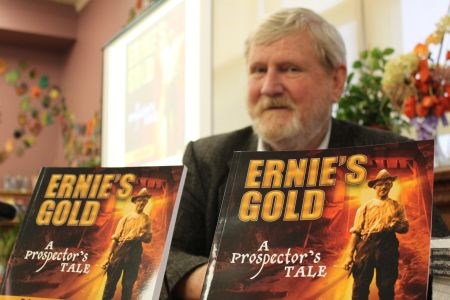Adventurer. Womanizer. Prospector. Ernie Martin was perceived as many things during his lifetime, but his most remarkable achievement is one that's not known well at all.
Martin was the co-discoverer of the gold deposit in Kirkland Lake that led to the establishment of Lake Shore Mine, one of the highest producing gold mines in Canadian antiquity, generating 8.5 million ounces between 1918 and 1965.
Historically, Sir Harry Oakes has taken most of the credit for the discovery. As the adventuresome American who travelled north to prosperity, his name is legendary in prospecting circles, synonymous with the Northern Ontario gold rush of the early 20th century.
But Brian Martin wants to put a new sheen on the story.
Growing up, he was regaled with tales of his great-uncle Ernie's shenanigans, and had been entrusted with photographs, documents and other mementos from his life. Martin, a reporter with the London Free Press, has now detailed his great-uncle's story in Ernie's Gold: A Prospector's Tale.
“Books about mining in Kirkland Lake made mention of Ernie Martin, but the full story had not yet been told and I felt it deserved to be,” Martin said during a recent book launch in Sudbury. “So, as a journalist with two crime books under my belt, I tackled the job.”
Ernie, as the story goes, first met Harry in 1911 when the two arrived north with dollar signs in their eyes. They worked shoulder to shoulder, mucking out holes and searching for the elusive vein that would bring them wealth. Harry trusted Ernie implicitly, and Ernie agreed to accept shares of the company in lieu of payment for his work.
Perpetually short of operating funds, Harry was off “hustling up prospecting money” the following year when Ernie discovered a chunk of rock that was later confirmed to be gold, Martin said.
“As a youngster, I recall my grandmother and father mentioning Uncle Ernie on many occasions...so I sensed no small amount of pride from them that Ernie had been fabulously successful and wealthy because of his discovery of gold in Northern Ontario,” Martin said.
But no amount of riches could tame the British playboy, who, while still married to his first wife, Mary Violette, took up with Vera, a mysterious trophy girlfriend, who entered his life at the peak of his wealth. Ernie was even bold enough to take his mistress along during a world cruise with Mary, so he could “cheat his way around the world under the nose of his unsuspecting wife,” Martin chuckled.
Ernie's philandering earned him a swollen, black eye and a divorce, and also marked the downturn in his good fortune.
After production at the mine waned and gold prices started to fall, Ernie's fortune—which had reached $13 million by 1936—dwindled to a mere $12,000. He willed the one property left in his estate to a waitress in Indiana to whom he had taken a shine in the later years of his life.
Brian Martin never met his great-uncle—Ernie died in 1949 “mere months” before his birth—but his story in print has arrived in conjunction with the 100th anniversary of the discovery of gold in Kirkland Lake, a fitting tribute to a family legend and the early prospecting years in the North.
“This is the very first telling of the story of Ernie Martin,” Martin said, “and I hope it will add to the knowledge of the early characters who made Kirkland Lake and all of Northern Ontario such an interesting area.”
Ernie's Gold: A Prospector's Tale is available through General Store Publishing House or Chapters.




